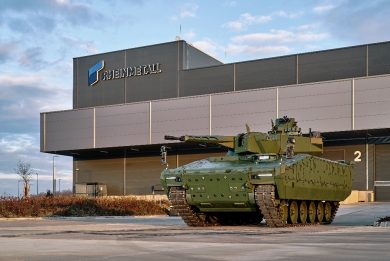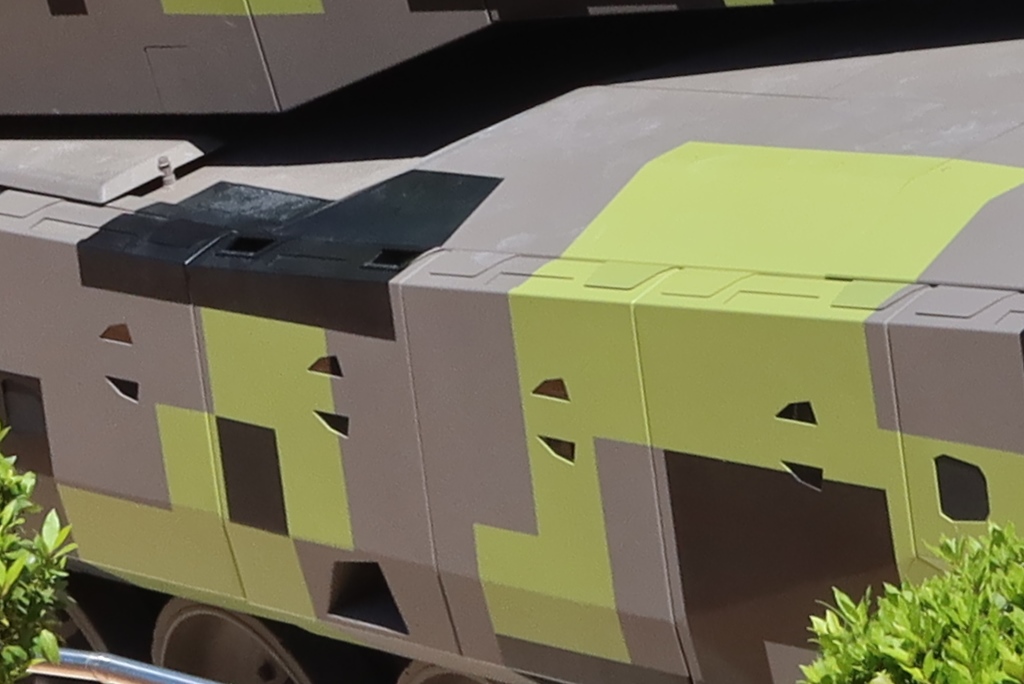
IAV Conference: Rheinmetall details its hybrid armour solution
The Chief of the German Army made it very clear: the future main battle tank weight must be under the 50 tonnes mark. Thinking that the original Leopard 2, the Leopard 2A0 if we number it according to the follow-on variants, was born in the late 1970s at 53 tonnes, the latest A7+ version being over 70, it is clear that some radical changing are needed. Rheinmetall identified the armour package as the MBT subsystem that can bring the greatest benefits in terms of weight reduction if a game-changing solution is adopted, as the protection component accounts for around half of the weight of a modern tank, the required weight saving being 23 tonnes considering the latest Leo 2 version, which means 33% of the whole tank mass and around half the estimated mass of its armour.
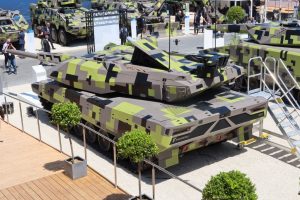
Along the years the Düsseldorf-headquartered group acquired a series of companies involved in the defence business, among which IBD Deisenroth which in the late 1990s launched its ADS, for Active Defence System, a solution that aimed at neutralise the major part of the lethality connected with incoming shaped-charge projectiles, tests then extending also to kinetic energy (KE) rounds such as APFSDS (Armour Piercing Fin Stabilised Discarded Sabot). With the acquisition first of a part of the company shares, then of the majority and now 100%, this became ADS GmbH, then Rheinmetall Active Protection GmbH and finally Rheinmetall Protection Systems, RPS in short, in 2019. RPS is part of the Weapons and Ammunition division and is the result of the merging of five different companies active in the passive armour, active protection, and soft kill domains, the new company being therefore able to provide turnkey protection solutions not only to Rheinmetall itself, but to other companies active in the land, naval and in civilian car armouring sectors which represent over 50% of the turnover. RPS has currently a manpower of around 420 personnel, over half of them being development engineers and scientists.
At the International Armoured Vehicles conference, which took place on 23-26 January at Twickenham, London, organised by Defence iQ, EDR On-Line could get more details on Rheinmetall “hybrid armour”, that was mentioned in early December 2022 at the company Defence Talks in Berlin as the solution adopted on the company Panther/KF51 MBT technology demonstrator.
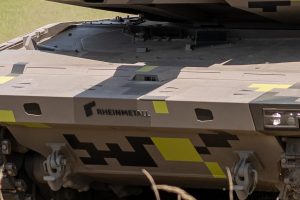
The “hybrid” adjective means that the armour module which is fitted onto the platform basic armour contains both the active and the passive elements, the active one being the third generation of the original ADS that is now known as Strike Shield, on which the hybrid armour is based. It therefore includes sensors, a window in the front armour in front of each of them allowing their correct functioning. These include a low power/short-range (around 30 meters) radar and an electro-optic sensor. As the sensors window would partly weaken the overall strength of the structure should residual elements hit the vehicle at this exact spot, here the passive armour is slightly thicker in that position in order to answer STANAG 4569/AEP-55 specifications. It is to note that as the Strike Shield radar sensor operates at short-range, it generates low power emissions that do not increase the tank electromagnetic signature. This allows to keep them always active.
Coming to the countermeasure, this is the energetic element of the package and is hosted inside the armour structure, the rear part of which is made of the passive armour package. This is capable to withstand the residual energy generated by the incoming projectile, following the action of the active element, without being perforated. EDR On-Line understood that an energy absorbing backing might be used in order to avoid any damage on the vehicle basic structure, should the rear part of the module, that is the passive armour, be the subject of a deformation. Although no numbers were provided, the hybrid armour is way lighter compared to a passive/reactive armour solution, the latter being mostly effective against shaped charges rather than against long rods. And this is the solution Rheinmetall is proposing to bring futures MBTs under the 50 tonnes mark as required by the Bundeswehr.
The original ADS was borne to counter mostly shaped charge systems, such as missiles of rocket propelled grenades, however as reaction times showed the system could also deal with KE projectiles, it was developed also to cope these which are of course the most critical threats, and which use has come back to surface with peer to peer confrontations becoming reality. KE tungsten penetrators leave the MBT gun muzzle at around 1,800 m/s, their optimal aerodynamic configuration allowing them to lose a minimal part of that speed, under 10%, at 1,000 meters distance, less than 20% in terms of reduced energy delivered on the target. However the aim of the hybrid armour is to avoid that energy to reach the target.
The radar is used as a pre-warning system to detect the incoming threat and wake-up the system, data provided to the Central Information Management (CIM or ADC – active defence controller) allowing its identification and classification. Should it be considered non-threatening, for example a small arms round, no action would be taken, however if it is classified as a threat identification is carried out, chemical energy or KE mostly based on projectile velocity, and the point of intercept hence the timing of ignition of the countermeasure are calculated, the electro-optic sensor providing confirmation.
As said, the most critical threat is that coming from large KE penetrators, therefore we will mostly concentrate on those. Comparing videos and images provided by Rheinmetall, which in the last three years worked intensely on optimising its active protection against long rods, it was possible to note that while initially the penetrator was destabilised and tilted by a limited angle, the latest images show it broken into pieces, usually three, sometimes four, with those residual elements impacting the armour surface at high angle, often well over 45°. According to unspecific sources, this allowed reducing the penetrator effectiveness up to 75%, results having been proved in numerous tests, our source pointing out that a further optimisation work is ongoing.
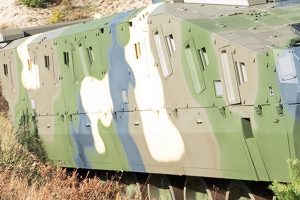
RPS being working both on active and passive solutions, it is well placed to fully optimise the passive component to cope with residual effects caused by APS when intercepting the threat. These include not only blast events or incoming solid materiel but, in the case of shaped charges, also non detonated explosive. In case the shaped charge managed to detonate albeit not in the optimal way, due to for example to early initiation, the passive armour has to deal with this. Residual effects are not categorised in the AEP-55 publication, and since one year RPS is working with 10 different categories of such effects. The company found that these can be applied both for distributed systems, such as the Strike Shield, as well as for launcher-based systems, however the feeling is that in real cases residual effects generated from the latter would considerably differ.
With short range detection and a high incoming speed, the system reaction time is one of the critical issues especially against KE rounds. In the past the ADS used fibre optic cables for connecting sensors to the CIM, the “brain” of the system, which had to identify the threat and ignite the relevant module to intercept it. However technology breakthrough allowed to avoid the use of fibre optics in the Strike Shield, these being definitely fragile and critical to use in an armoured vehicle. As new high speed databus were developed in the automotive world, Rheinmetall acquired the license for producing them, not before modifying some parameters in order to ensure the required accuracy and time for their use in active protection, where reaction times are close to the millisecond if not lower. Connectors are located between tiles, while splitters allow distributing both power and signals to sensors and countermeasures. A tank can be fitted with two CIMs, one connected to hybrid armour elements on the turret while the second is in charge of those on the chassis, the two being of course correlated in order to avoid overkill. Infantry fighting vehicles would have a single CIM; it is to note that for those lighter vehicles Rheinmetall started considering only now the possibility to protect some areas from KE threats, simulation work being currently ongoing.
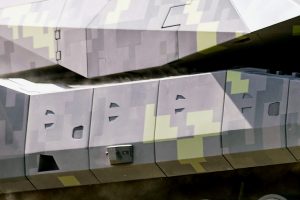
EDR On-Line was given the chance to discuss the layout of the hybrid armour elements on an MBT. Along the vehicle sides the energy generated by the countermeasure would be directed diagonally in the horizontal plane, fired at an angle hitting the incoming round on the spit. Two or even four modules can cover the same sector, however it is unclear if the angle in the horizontal plane is variable or fix. The overlapping ensures multiple-impact resilience, but it might also be used to ignite two countermeasures at the same time should the controller estimate it as a difficult engagement. It is however useful to remind that not all countermeasures are identical, those designed for KE threats being able to generate a greater energy compared to those in charge of HEAT warheads; therefore KE countermeasures are able to defeat shaped charge threats, while the contrary is not true. Countermeasures installed at the front of the tank would generate energy upwards, to engage penetrators traveling towards the turret.
This would also be protected by a layer of reactive armour; this is not of the classic type, aimed at defeating shaped charges and activated by the explosively formed penetrator generated, but is a pre-detonated armour that exploits the active elements sensors to intervene at the right time. As for the rear part of the tank, countermeasures are oriented towards the ground, protecting the platform’s powerplant.
Replacing an expended module can be done at forward base level, using a forklift and two maintainers, the modules following the logic of add-on armour kits. The Central controller provides the health monitoring capacity, allowing the crew as well as logisticians to check the integrity of the whole system.
As for a possible use of hybrid armour against top-attack threats, Rheinmetall considers this a last-ditch solution, soft-kill systems being easier to install and to qualify. Both solutions can exploit the same threat library available to active countermeasures, as well as threat classification algorithms, the top-attack probably needing dedicated higher power radar sensors, to detect incoming threats and activate firstly soft-kill solutions and eventually hard-kill ones. The electromagnetic emission of those sensors would have a relative impact on the vehicle EM signature as they will be directed upwards, with limited changes to be intercepted by opponent’s EW land systems. Rheinmetall said that the Bundeswehr has issued the requirements for top attack defence systems, industry being therefore now working on those data for developing such solution.
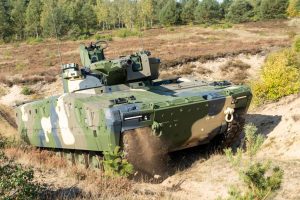
The first customer to have selected the hybrid armour on an IFV was Hungary, on its new Lynx/KF41 tracked vehicles, their armour package being based on passive spaced armour with the Strike Shield integrated into the spacing. This passed functional acceptance tests in October 2021 after two years of development, under close supervision of the German Bundeswehr quality and assurance bureau, which worked together with its Hungarian counterpart. Following those tests, carried out against single- and tandem-shaped charge projectiles (a specific Hungarian requirement), the Magyar Honvédség decided to acquire the hybrid armour package for nearly the whole fleet.
Tests for tank application were intensified at the beginning of the current decade, development work being carried out in cooperation with the Bundeswehr. The reference threat in the KE domain is the Russian BM-42 125 mm APFSDS round, which 570 mm tungsten penetrator weighs 4.85 kg and has a muzzle velocity of 1,715 m/s. EDR On-Line understood that tests were carried out also with western 120 mm rounds fired at 200 meters distance, which allows simulating a higher velocity on target typical of state-of-the-art and/or future threats. According to information obtained, further tests and demonstrations should be carried out in 2023.
The hybrid armour proposed by RPS is an open and modular system, and can also accept launcher-based system, that might be used to neutralise missile and RPG threats at greater distances. According to the company the best approach for ensuring the greatest weight reduction and maximum effectiveness of its hybrid solution is to start working with the platform provider since the beginning of the project, which allows integrating it as deep as possible in the design. This doesn’t mean that it should not be considered for upgrading existing platforms fitted with modular add-on armour, however the resulting slimming care would be less effective than in a newly designed vehicle.
Photos courtesy Rheinmetall and P. Valpolini

